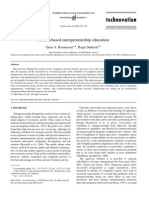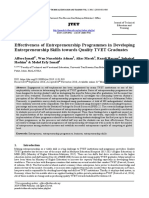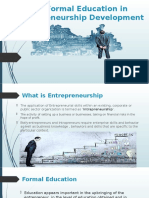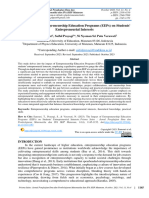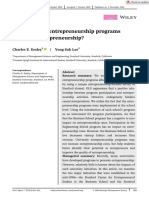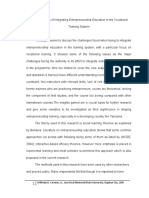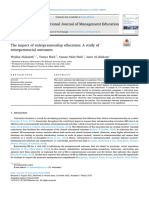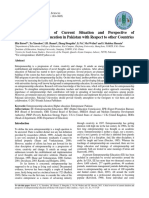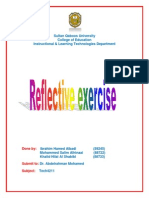Assignment Title: Critical Literature Review – Virtual Lab
Course: Research Methods
Topic: The Role of Entrepreneurial Education in Shaping Start-up
Success in the UAE
Name: Ghareibah Muhammed Alyammahi
1
�1st Article: Syed et al. (2024). Digital entrepreneurship education in universities through the
lens of educators: evidence from the UAE. ( Relevance: The study provides direct insight into
how UAE universities are currently delivering digital entrepreneurship education and highlights
gaps between academic programs and real-world startup demands.)
Summary: The qualitative study looks at how digital business is taught in universities in the
UAE right now from the point of view of the teachers. The writers used an inductive and social-
constructivist method to do in-depth, semi-structured conversations with university professors of
business. There was a clear disconnect between what was taught in schools and what employers
wanted. Teachers thought that classes put too much emphasis on general information and not
enough on useful digital skills. The study shows what might happen to the UAE's business
environment if digital startup training was better matched.
Strengths: Syed et al. take a new approach by talking to teachers instead of students, which
gives them deep qualitative insights into gaps in the way they teach. They make it clear that this
method is "inductive and social constructivist," which "distinguishes this research" from other
work that has been done. There are both state and private universities in the group, so it has a
wide range of points of view. The study fills an important gap by focusing on digital
entrepreneurial education, which is a new area. It also connects the results to national policy,
such as the UAE's goal for an innovation-driven economy. The detailed suggestions (on
education and policy) add real value.
Weaknesses: The study is based on a small, context-specific group of educators. As the writers
admit, it is limited to UAE colleges and a relatively small number of interviews. Relying on self-
reported views adds possible biases (participants may give socially desired answers). Because
the study is exploratory and informal, it does not measure results (e.g. student ability or company
success rates).
Theoretical Framework: Syed et al. specifically draw on Human Capital Theory (HCT) and the
Entrepreneurship Teaching Model (ETM). HCT views education as growing individuals’
skills/knowledge that drive economic growth, emphasizing the importance of educators’ ability
to teach digital business skills. The ETM ties teachers’ views and understanding to real teaching
methods.
2
�Critique: Syed et al.’s paper clearly finds gaps between present teaching and market needs,
offering rich qualitative proof. Its strength is stressing the “lens of educators” – a group seldom
studied – and giving practical suggestions for UAE lawmakers and colleges. The major flaw is
that it stops short of linking education to real business results. We do not learn, for example, how
students’ digital businesses actually work.
2nd Article: Zarrouk et al. (2021). Exploring economic and technological determinants of
FinTech startups’ success and growth in the UAE. ( Relevance: the paper identifies key success
factors—like access to finance and business model quality—that entrepreneurial education in the
UAE should address to enhance startup outcomes.)
Summary: The mixed-methods study examines factors affecting the growth of UAE-based
FinTech companies. The writers note that the UAE has quickly become a regional FinTech hub,
but there is little actual data on what drives FinTech success. They handle this by asking 32
FinTech leaders using a semi-structured questionnaire, then running qualitative analysis and an
ordered logistic regression. The main finding is that availability of resources – especially VC
funds – is “vital to the success and survival of FinTechs”.
Strengths: The paper is pioneering in quantitatively exploring UAE FinTech success causes. By
mixing founders’ personal thoughts with quantitative modeling, it gives a multi-faceted view.
Conducted in the UAE’s changing FinTech climate, its background is highly important. The
study’s use of an ordered logistic regression on real founder data adds some accuracy.
Weaknesses: The study is limited by its small sample of 32 startups (and 8 founders/co-
founders). This is too few to generalize safely or discover smaller effect sizes. The study is also
special to FinTech, so results may not stretch to other company areas. The cross-sectional poll
methodology means cause cannot be clearly established; as the authors admit, the model “cannot
explain why” certain factors matter. Self-reported success measures could be biased.
3
�Theoretical Framework: Zarrouk et al. do not test a formal theory; rather, they adopt an
experimental entrepreneurial-ecosystem view. Their opening cites Schumpeterian economics –
that financial development spurs innovation and growth – as reason for considering finance and
technology in FinTech. One could read the study as weakly grounded in the resource-based view
of the firm: success is tied to resource access (capital, technology, networks). They also consider
business ecology theory by studying legislative and infrastructure factors.
Critique: Zarrouk et al.’s study shines a spotlight on the financial and societal levers of FinTech
success. Their finding that VC funding is “vital” underscores a realistic fact for UAE officials.
Nevertheless, the article’s effect is limited by its size. As the authors suggest, broadening to
bigger groups (and comparing different countries) would increase trust in the data.
3rd Article: Hameed et al. (2016). Science, technology and innovation through
entrepreneurship education in the UAE. ( Relevance: This research quantitatively demonstrates
how entrepreneurship education in UAE universities positively influences students’ motivation,
achievement needs, and innovation—core drivers of startup success.)
Summary: The quantitative study examines how entrepreneurship education promotes science,
technology, and innovation (STI) in the UAE. Focusing on a university in Al-Ain, the authors
surveyed 251 students, measuring independent variables (entrepreneurship education
dimensions) and intervening variables (self-confidence, locus of control, risk-taking) on
outcomes (innovation, need for achievement, drive).
Strengths: Hameed et al. employ a large sample (251) and perform rigorous SEM analysis,
lending statistical weight to their findings. They go beyond simple attitudes to measure specific
outcomes (innovation, need for achievement, motivation), thus capturing multiple dimensions of
entrepreneurship influence. The paper’s novelty lies in explicitly tying entrepreneurship
education to national STI goals, an area not widely studied. Its use of established scales and
structural modeling improves reliability.
4
�Weaknesses: The sample is taken from one UAE university and may not represent all Emirati
students. The study is cross-sectional and rests on self-reported survey data, which may introduce
common-method bias and limit causal claims. The constructs (e.g. “innovation” or “motivation”)
are judged by proxies rather than actual outcomes (startups formed, patents, etc.), so real-world
effect is unclear.
Theoretical Framework: Hameed et al. ground their work in traditional entrepreneurship and
motivation theories. In particular, they draw on Schumpeter’s theory of innovation
(entrepreneurs drive economic growth by creative “destruction”) and McClelland’s learned need
theory (achievement motivation) as conceptual backdrops. These theories suggest that
entrepreneurship education should foster a desire to innovate and a tolerance for risk.
Critique: The study offers important empirical evidence that entrepreneurship education
correlates with students’ motivation and perceived innovation capacity in the UAE context. Its
strength is statistical rigor and tying findings to national STI goals.
4th Article: Hanandeh et al. (2021). The impact of entrepreneurship education on innovative
start-up intention: the mediating role of entrepreneurial mind-sets. ( Relevance: By examining
how different types of entrepreneurship education influence students’ entrepreneurial mindsets
and startup intentions, the study reinforces the importance of mindset development in
educational programs.)
Summary: The study examines how university entrepreneurship education affects students’
desire to create innovative startups, focusing on the mediating role of entrepreneurial mindsets.
The authors surveyed 204 students at a Jordanian university (Amman Arab University) and used
Structural Equation Modeling (SEM) to evaluate the data. Entrepreneurship education was split
into three types: curricular programmes, extracurricular programmes, and social education.
Strengths: Hanandeh et al. use a robust quantitative methodology (SEM with clearly stated
constructs and validated survey items), which allows testing complex mediation hypotheses.
Their multi-dimensional approach to education (curricular, extracurricular, social) represents the
complete “ecosystem” of entrepreneurship teaching. Introducing the idea of the entrepreneurial
mindset as a mediator adds nuance beyond past studies that looked only at direct effects on
intention.
5
�Weaknesses: The study is limited to one school and region, so results may not generalize across
all UAE or MENA universities. It relies entirely on student self-reports at one point in time, so
there is possible common-method bias. As with other intention studies, it predicts intention rather
than tracking real startup formation.
Theoretical Framework: Hanandeh et al. frame their work partly via educational theory of
business. They specifically reference Keen’s Theory of Change, which views curricular programs
(courses, case studies) as tools to create an entrepreneurial mindset. This grounds the idea that
classroom learning can reshape students’ outlooks.
Critique: Hanandeh et al.’s results add evidence that university programs can cultivate the
mindsets that spur startup intent. By dissecting education into types, they give actionable
information (for example, emphasizing curricular design as most effective). However, the
practical significance is tempered by the study’s scope: we don’t know if higher intention leads
to more startups or economic effect.
5th Article: Al Hashimi et al. (2021). The role of nurturing technopreneurship education and
building university students’ entrepreneurial mindsets in fostering digital innovation and
augmenting the tech start-up ecosystem in Bahrain. ( Relevance: the paper explores how
educational experiences shape the success of digital startup founders, offering transferable
lessons for technopreneurship education)
Summary: The qualitative exploratory study examines the link between education and startup
success in Bahrain’s tech industry. The authors interviewed eight founders of successful Bahraini
digital startups (mobile apps) and officials from twelve tech-support organizations (incubators,
accelerators, etc.). Key findings include that no single degree guarantees tech startup success;
rather, education that fosters creative thought, innovation, teamwork, and practical tech skills is
important.
6
�Strengths: Al Hashimi et al. delve into an under-researched context (Bahrain) and combine
views of founders and ecosystem actors. The semi-structured interviews yield rich, detailed
insights that surveys could miss (e.g. founders openly discussing curriculum relevance).
Including support organizations adds breadth, ensuring views beyond the founders themselves.
The study is policy-relevant: it compares global best practices and adapts them for Bahrain’s
higher-education system.
Weaknesses: The group is very small and specific (8 founders, all from Bahrain). Though in-
depth, it is not generally representative. The retrospective, self-report nature means results are
subjective (recall bias, survivorship bias: only successful founders were interviewed).
Generalizability beyond Bahrain or tech startups is restricted. The study is exploratory rather
than theoretical: it does not test hypotheses or elaborate a framework.
Theoretical Framework: Al Hashimi et al. do not directly invoke a theoretical model. Their
approach is based in educational and entrepreneurial ecosystem thinking: they implicitly assume
that education (curriculum, skills training) and ecosystem supports (mentors, incubators) jointly
promote startup success. One could assume a human capital viewpoint here: education imparts
skills and attitudes that entrepreneurs need.
Critique: The work offers practical, context-specific advice for Bahraini universities and
policymakers. Its strength is in giving voice to local technopreneurs and comparing their ideas to
global standards. However, by focusing on a very niche section (digital apps, Bahrain), it offers
limited general lessons about UAE entrepreneurial education.
Synthesis of Findings:
Entrepreneurial Education and Mindset Development
entrepreneurial education positively shapes students’ mindsets and goals toward startups.
Hanandeh et al. (2021) find that curricula and social entrepreneurship programs greatly enhance
students’ entrepreneurial mind-sets, which in turn drive innovative startup intentions. Syed et al.
(2024) similarly stress the educators’ role in “fostering an entrepreneurial mindset” by imparting
both knowledge and skills. Al Hashimi et al. (2021) put “creative thinking and innovation skills”
as the top attributes linked to startup success, highlighting that education should instill these
mindsets.
7
�The Importance of Content and Delivery Quality
The content and quality of education count. Several authors note gaps between what is taught
and what the business demands. Syed et al. report a large “gap between digital entrepreneurship
education and industry expectations”, calling for updated curricula and industry collaboration. Al
Hashimi et al. identify a similar shortfall: founders suggest that traditional theoretical courses
alone did not suffice, stressing instead interdisciplinary, hands-on technopreneurship skills.
Hameed et al. (2016) find that entrepreneurship education must go beyond theory to build
students’ self-confidence and risk-taking propensity if it is to spur creativity. In synthesis,
successful startup preparation in the UAE appears to require both formal courses and extra-
curricular experiences that stress creativity, technology, and real-world problem-solving.
The Role of National Ecosystem Factors
national ecosystem factors interplay with schooling. Zarrouk et al. (2021) stress that beyond
education, resource availability and regulatory environment are crucial: venture-capital funding
and supportive laws are “vital to the success” of FinTech startups. This complements the
education-focused studies: even well-trained entrepreneurs need cash and an enabling ecosystem.
Gaps in the Literature:
Limited Scale and Scope of Studies
most studies are limited in scale and scope. Syed et al. (2024) and Zarrouk et al. (2021)
themselves admit that their small, context-specific samples restrict generalizability. There is a
clear need for larger, multi-university and cross-country samples in the Gulf to validate these
results. Longitudinal research is also lacking: we have cross-sectional surveys and interviews,
but few studies track students over time to see if education actually makes sustainable startups.
In other words, empirical proof linking education programs to measurable startup success is
scant.
8
�Theoretical Inconsistencies
Moreover, theoretical growth could be deeper. Three of the five pieces (Syed, Zarrouk, Al
Hashimi) do not anchor their analysis in a formal entrepreneurial theory, and even the others use
disparate frameworks. A unified conceptual model of how education translates into venture
success – perhaps integrating human capital theory with entrepreneurial ecosystem theory –
needs to be developed for the UAE context.
Sectoral Limitations
The focus of existing literature is narrow in terms of industry sectors. For instance, Zarrouk et al.
(2021) focus solely on FinTech, leaving open questions about how entrepreneurial education
affects other fast-growing sectors in the UAE, such as healthcare, green energy, or AI. Broader
sectoral analysis is needed to develop comprehensive, inclusive educational strategies for the
entrepreneurial ecosystem.
9
�References:
Al Hashimi, S., Zaki, Y., Al Muwali, A., & Mahdi, N. (2021). The role of nurturing
technopreneurship education and building university students’ entrepreneurial mindsets
and skill sets in fostering digital innovation and augmenting the tech start-up ecosystem
in Bahrain. International Journal of Learning, Teaching and Educational Research, 20(6),
152–173.
https://www.researchgate.net/publication/353501851_The_Role_of_Nurturing_Technopr
eneurship_Education_and_Building_University_Students'_Entrepreneurial_Mindsets_an
d_Skill_Sets_in_Fostering_Digital_Innovation_and_Augmenting_the_Tech_Start-
Up_Ecosystem_i
Hameed, I., Khan, M. B., Shahab, A., Hameed, I., & Qadeer, F. (2016). Science, technology and
innovation through entrepreneurship education in the United Arab Emirates (UAE).
Sustainability, 8(12), 1280. https://www.mdpi.com/2071-1050/8/12/1280
Hanandeh, R., Alnajdawi, S. M. A., Almansour, A., & Elrehail, H. (2021). The impact of
entrepreneurship education on innovative start-up intention: The mediating role of
entrepreneurial mind-sets. World Journal of Entrepreneurship, Management and
Sustainable Development, 17(6), 1123–1142.
https://www.emerald.com/insight/content/doi/10.1108/wjemsd-02-2020-0016/full/html
Syed, R. T., Alzahmi, R. A., & Tariq, U. (2024). Digital entrepreneurship education in
universities through the lens of educators: Evidence from the United Arab Emirates.
Cogent Education, 11(1), 2409472.
https://www.tandfonline.com/doi/abs/10.1080/2331186X.2024.2409472
Zarrouk, H., El Ghak, T., & Bakhouche, A. (2021). Exploring economic and technological
determinants of FinTech startups’ success and growth in the United Arab Emirates.
Journal of Open Innovation: Technology, Market, and Complexity, 7(1), 50.
https://www.mdpi.com/2199-8531/7/1/50
10
�11







